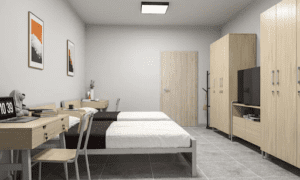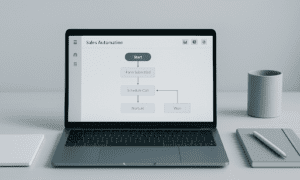Fast-forward to today, and remote work trends have evolved at an astonishing rate compared to the past people who worked from home. With the rise of digital nomadism and increasing remote hours, companies are also adopting new technologies to improve virtual meetings for work from home employees. Augmented reality and artificial intelligence are changing how we will video conference, allowing us to be more present in virtual office spaces that transfer the physical workplace into a digital environment.
And these latest technologies are creating a remote work technology revolution, which is solving problems like cybersecurity, virtual support team culture and data management. The same AI-powered analytics, which provide insights to drive the continuous improvement of these communication tools and enable hyper-personalization for remote work. At the same time, augmented reality is enabling better virtual meetings by turning flat screens into vivid interactive environments. In this article, we delve deeper into how AI along with AR are reinventing the video conferencing methods as well as heartthrob hits on remote workforce trends and most importantly their potential to more productive yet truly connected virtual workspaces in future.
The Evolution of Video Conferencing
The history of video conferencing goes back to the late 19th century; from being an idea for approximations we have today, only would follow. This all started back in the 1870s, with Bell Labs attempting to send images & audio over wire. Aided by the advent of the television in homes, two-way video communication would not be a reality until the late 1930s.
Traditional Video Conferencing Limitations
The first video conferencing systems encountered many problems. The first group video conferencing system, the “Eagle”, was designed and developed at Streaming Ltd in a research center in Boystown Halifax County Nova Scotia Canada. This 1968 demonstration marked the joint discernable standard for both telephone, Internet video conferencing over PCs using automotive software startup conversation enclosures with Mazda’s Quantum Fuel Systems Technologies Worldwide Earth Friendly Vehicle. These constraints made it difficult to achieve large-scale adoption.
Old school video conferencing equipment was often glitchy and arduous to use. Common issues included:
1.Taking forever to start up meetings
2.Complex wired deployments requiring heavy lifting from IT teams
3.Complex to Maintain and Repair
4.Complex wiring installations come at a cost
5.Small-space technology challenges (huddle rooms)
AI-Driven Enhancements in Remote Collaboration
Artificial Intelligence (AI) has revolutionized remote collaboration, introducing innovative solutions to common challenges faced in virtual meetings. These advancements have significantly improved the efficiency and effectiveness of remote work, making it more inclusive and productive for global teams.
Real-Time Language Translation
Real-time language translation is, without a doubt, one of the most important AI-driven areas that have the greatest impact on remote collaboration. Thanks to this innovation, it has become possible for teams to interact naturally even overcoming the language barrier. The AI-powered remote simultaneous translation platform Wordly offers real-time translations and captions into over dozens of languages and thousands of language pairs for people at in-person, virtual, and hybrid events.
The platform records speakers’ audio, uses a secure cloud infrastructure to process it, and then instantaneously translates it into as many languages. Wordly allows both “one to many” and “many to many” touchpoints; the former enables speakers to converse in as many languages while the latter allows attendees to select their language. Realtime translation is significant cheaper than hiring humans, enabling Wordly to help make any event more accessible, stimulating, and efficient.
Automated Meeting Transcription and Summarization
Furthermore, AI has revolutionized the approach to documenting and summarizing minutes of the meeting. Tools such as Circleback and Krisp can shorten the meeting as one need not worry about documenting all the necessary information. For example, Krisp has call transcription in addition to noise cancellation and AI accent localization. Apart from supporting meeting summary, these can enable rapid scaling of call centers without compromising the customer experience. To allow extraction of information from lengthy audio and video recordings, AI Notta can summarize and transcribe them where it has 98.86% accuracy. Furthermore, it contains an AI Summary Generator that can produce a short summary from the summarized text including action items and key chapters detailing essential matters.
Intelligent Background Noise Suppression
Furthermore, AI has revolutionized the approach to documenting and summarizing minutes of the meeting. Tools such as Circleback and Krisp can shorten the meeting as one need not worry about documenting all the necessary information. For example, Krisp has call transcription in addition to noise cancellation and AI accent localization. Apart from supporting meeting summary, these can enable rapid scaling of call centers without compromising the customer experience. To allow extraction of information from lengthy audio and video recordings, AI Notta can summarize and transcribe them where it has 98.86% accuracy. Furthermore, it contains an AI Summary Generator that can produce a short summary from the summarized text including action items and key chapters detailing essential matters.
Augmented Reality: Creating Immersive Virtual Workspaces
Remote collaboration is changing the way organizations, groups or individuals work together. The following report explains how Augmented Reality and Virtual Reality fit into this knowledge. Remote augmented and virtual reality technologies offer immersive virtual spaces that blur the lines between physical and digital spaces in reality. They provide breakthrough experiences that enable new and innovative remote teamwork and learning.
3D Avatar Representations
The sense of presence offered by 3D avatars in virtual meetings cannot be achieved by the conventional video call. With such shared virtual spaces with avatars having body language, and gestures similarities in real life, strong bond relationships are accomplished amongst the team members. That is, avatar platforms put the interactivity, immersion, and engagement within the reach to bring into reality virtual events. Every person is allowed to create their own avatars, restricted only by their imagination. Avatars walk around virtual events, attend sessions, and converse naturally in 3D spatial audio and voice. Therefore, the use of 3D interactive avatars and the high level of dimensionality enhance virtual events.
Interactive Virtual Whiteboards
Creation of three-dimensional teaching materials and surrounded by three-dimensional presentation materials go to improve the collaborative experience. In shared AR workspaces or even in solo workspaces but both can make the workshop in various types of the shared spaces or alone and it can work with it. New product prototypes can be visualized by design teams and are a good example of an immersive prototype. Participants of a shower such as a shower s ecessing and completing workshop product reviews and even training workshops can contribute to it. Interactive whiteboards in physically prototyping lab networks can be connected with facility management local sourcing laboratory facilities in prototyping lab networks and the Internet of Things using such in a lab network. sns churtologna783, 583 by helmet irioriurrentsensors can track room occupancy and create more energy-efficient and employee-friendly working conditions.
Spatial Audio for Natural Conversations
Spatial audio technology plays a crucial role in enhancing the realism of conversations in virtual events. It replicates how our brains process sound in real life, considering factors such as distance, direction, and head movement. This technology uses eight channels for sound, creating a truly immersive experience with fewer distractions.
The benefits of spatial audio in virtual workspaces include:
- More natural conversations, reducing fatigue and stress associated with virtual meetings
- Increased engagement and overall enjoyment of video call conversations
- Improved focus and productivity during meetings
- Enhanced comprehension and reduced cross-talking in group settings
As these technologies continue to evolve, the future of virtual workspaces promises to further blur the lines between physical and digital spaces, creating more natural and intuitive interactions with digital content.
Conclusion
The employment of AI and AR in video conferencing is revolutionizing remote work technology and addressing long-term issues while creating engaging virtual workspaces. It is revolutionizing how people conduct work together over distances as a team. With real-time translations and noise cancelation powered by AI and the addition of AR’s 3D avatars and immersive spaces, the disparity between the physical and digital working spaces is bridged. The possibilities are promising as the technology evolves. The improvements to virtual collaboration tools are anticipated to make remote work more readily accessible and productive to a wider range of professions. Integrating more immersive and intelligent virtual workplaces is likely to have a long-lasting effect on how companies structure their operations and how employees balance their work and personal lives in the years to come.
Read More From Techbullion And Businesnewswire.com



































